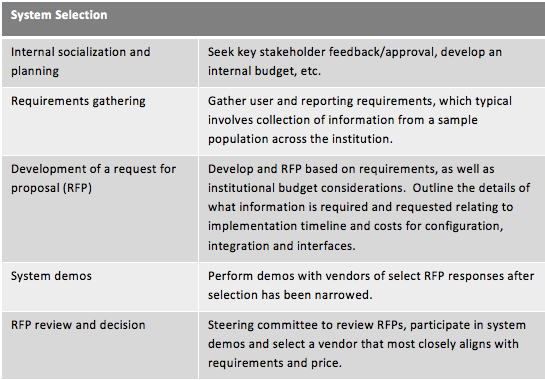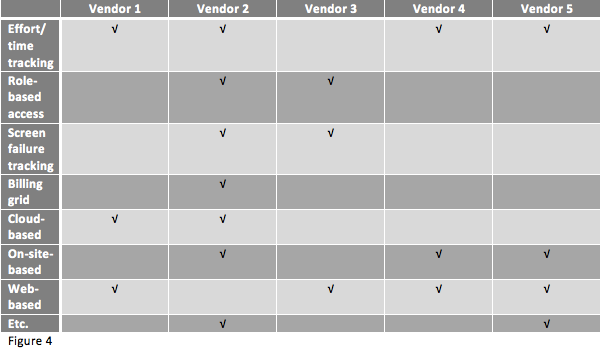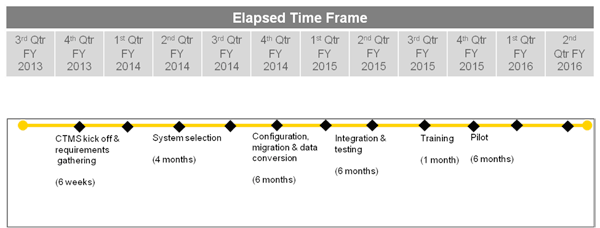Academic Medical Centers Can Tackle CTMS Successfully
The excessive cost of clinical trials mixed with the inefficiency of clinical trial management is a widespread problem among research institutions.
The excessive cost of clinical trials mixed with the inefficiency of clinical trial management is a widespread problem among research institutions. As the importance of translational research continues to grow, with focus placed on comparative effectiveness and outcomes-based research through the new health care reform acts, research institutions need to “step it up” if they want to remain competitive players in the academic clinical research arena. Most academic medical centers (AMCs) are plagued with many of the same issues, including:
- Decentralized departments leading to inconsistent administrative processes
- Poor institutional review board (IRB) functionality
- Lack of real-time data available to both investigators and leadership and the inability to successfully track and schedule patients
- Bottlenecks in knowledge transfer between various entities involved in research
- Human errors in reporting that often cause compliance issues
- Missing milestones for grants, awards, fellowships, etc.
- Inadequate financial structure - billing and invoicing issues leading to disparities in payment and potential compliance issues
Exploring the benefits of CTMS
Research institutions can look to clinical trial management systems (CTMS) to alleviate the burdens associated with clinical research management. By implementing CTMS, research institutions are moving away from antiquated non-integrated manual processes and turning to technical solutions to mitigate the above-listed problems associated with conducting clinical trials.
Figure 1

A successful CTMS can provide a well-organized flow of knowledge throughout the institution and help senior management obtain real-time data to better analyze the current state of the clinical research landscape. Armed with milestone-based, real-time data, senior management is better equipped to make strategic decisions to improve overall operational effectiveness, compliance, governance and infrastructure (see Figure 1). The list below highlights some of the operational, infrastructure, compliance and governance issues that can be improved by implementing a CTMS:
- Staffing: With a better understanding of resources, management will be capable of reallocating staffing assignments to offset excess or inadequate roles.
- Communication: Improved communication will improve patient satisfaction and monitoring of clinical trials.
- Human error: CTMS have integrated checking components to limit errors in reporting.
- Operational flow: Improved knowledge flow in various divisions (finance, marketing, administration, training and recruitment) will help to achieve real-time results and data.
- Managing clinical data: More accurate and efficient reporting tools will be useful internally and externally for current and future project assessments.
There are three general types of CTMS: web-based, cloud-based and on-site hosted-based software. Each type has advantages and disadvantages depending on the IT infrastructure at the respective academic medical institution. In the next section, we will further discuss how to map the system and conduct a gap analysis of your research institute needs. During the mapping exercise, the following uses should be explored to enable the implementation of a well-balanced, operationally efficient and financially effective CTMS:
- Improvements in clinical, administration and financial management of research
- Fostering and improving collaborations among investigators
- Greater understanding of the progress and revenue impact of clinical trials
- Increasing subject recruitment and safety through the institution
- Reducing errors and increasing facility compliance
- Operating efficiently and saving research time
Figure 2

Unfortunately, although CTMS have the potential to solve many of the compliance, governance, operational and managerial issues at research institutions, there is currently no perfect, one-size-fits-all CTMS available in the market, and implementation is often challenging. Even though there is no perfect system, there are common elements among most of the best systems:
- Financial reporting tools (coverage analysis, residual and overage reporting)
- Clinical trial management tools (including applicable clinical trial milestones and reporting dashboards)
- Searchable clinical trial database
- Data warehousing module
- Recruitment support module
- eCRF
As the market demand for computerized CTMS increases, so does the number of systems solutions. Thus, we may be getting closer to a system that effectively manages all aspects of the clinical trial process at AMCs. Until then, any CTMS implementation will require a certain amount of mapping, customization and implementation support. Unfortunately, these elements are as costly as they are necessary.
Figure 3

Procuring the right CTMS for your research institute
Prior to purchasing or implementing a CTMS, it is necessary to assess the institution’s operational, compliance and governance needs and priorities, as well as outline current software systems. Establishing priorities and identifying current systems can be done in mapping sessions. In a mapping session, a cross-functional team of principal investigators, study coordinators and senior leadership (such as the chief information officer, chief financial officer, human resources representatives and chief compliance officer) are allowed to identify future system requirements, outline current software system gaps and weight operational, governance and compliance priorities. For instance, leadership may require certain compliance management reporting capabilities, while investigators may require that the system track pre-award study start-up milestones.
Figure 4 illustrates a typical mapping exercise. Next, a gap analysis of the research institute’s current software system’s capabilities and the requirements identified in the mapping sessions versus CTMS-specific capabilities is completed. The analysis will help to identify the best CTMS fit for the institution.
After mapping system requirements and establishment of priorities are completed, the vendor selection process can begin. Based on the mapping, most institutions will not be able to pick a system off the shelf that is fully operational for their clinical research needs. This makes choosing a system somewhat more complicated than implementing other types of institutional systems such as financial, electronic health management, and other point of service systems.
Sample mapping grid (illustration only)
Figure 4

Cost factors and implementation overview
CTMS are expensive to implement. It is essential to take all implementation costs into consideration before choosing a CTMS. Many systems offer somewhat low “off the shelf” prices, but these prices don’t reflect the true cost. It is necessary to consider not only the cost of the system itself, but the cost of customization, migration of data from legacy systems, integration with other systems, training and roll out timeline when choosing a CTMS. Third-party assistance during the system selection phase is often beneficial for institutions wanting a comprehensive approach to making such a large investment.
Figure 5

Purchase and implementation of a CTMS often means a commitment of two or more years and can cost upwards of $3 million. Institutional commitment, as well as any outside consulting services, should be dedicated to implementation. Furthermore, successful implementation must be supported by senior leadership and managed by a project management team. In our experience with the implementation of CTMS, the following are key aspects of the process:
- Building an executive committee: The most important aspect of implementing a CTMS is having a committee that is capable of making well-informed decisions for the institution.
- Forecasting future issues: Know the current and future issues of the institution that hope to be resolved with the CTMS.
- Adapting to change: Understand that implementing a CTMS will come with new responsibilities. The institution should be prepared to have individuals fill these new roles. Without this preparation, the CTMS is doomed from the beginning. New hires might not be necessary, but rather a shift in responsibilities. Create a culture of transparency to eliminate conflict and inconsistencies in the future.
- Training and preparation: Design an ongoing tailored training program to meet the short and long-term needs of staff. Implement training and train staff on the new technology.
- Hiring an external firm: Consider bringing in an unbiased firm to help people in the institution understand the benefits of change. An external firm can also provide management with options for implementation, interface and utilization.
Figure 6

Conclusion
As mentioned above, although it is crucial, it is no longer enough to have a stand-alone system that tracks studies or helps produce management reports on clinical trials. In reality, a truly successful technological solution to clinical trial management will require integration with other systems such as EMR, IRB and financials. This is currently an area in which most CTMS have not succeeded, and one that, again, will become increasingly important through health care reform and as the bridging of payers and providers to determine quality standards becomes more commonplace. Institutions need to be able to link CTMS with the other institutional systems. The integration will help create a powerful database for management, and institutions will have real-time access to data allowing them to maintain and manage various stages of clinical trials. Researchers will have the ability to keep up-to-date contact information for participants and track deadlines and milestones.
A successful CTMS connects all aspects of clinical trial management and allow administration to focus on balancing the financial reports with accurate and real-time recruitment data. Along with strategic, governance and operational improvements, a successful CTMS can improve patient satisfaction, increase ROIs, enhance communication between departments, increase the volume of completed trials, and generate an overall more efficient clinical research portfolio.
The views expressed herein are those of the authors and do not necessarily reflect the views of Ernst & Young LLP.
About the authors
Erika Stevens is a senior manager in the Advisory Services practice of EY. Erika has more than 18 years of academic medical center, hospital and clinical research experience, including more than 15 years in clinical research management serving in roles such as the director of the Clinical Trials Office, regulatory training manager, director of clinical research and director of research operations. Erika is the chair of the editorial advisory board for The Monitor, the peer-reviewed journal publication for the Association of Clinical Research Professionals, and she serves on the Global Conference Planning Committee.
Christina Eberhart is a manager in the Advisory Services practice of EY. She has more than 13 years of clinical research experience, contributing in such roles as director of clinical operations, director of quality assurance, clinical research associate, manager of quality assurance and the principle of an investigator trial network. Christina is a national speaker on several clinical research topics for the Association of Clinical Research Professionals, Drug Information Association and MAGI.
Jim Moran is an Executive Director in the Advisory Services practice of EY with more than 18 years of experience working with universities, hospitals, academic medical centers and cancer centers as a research operating officer, chief compliance officer and consultant. Jim’s deep industry background includes developing multi-million dollar growth platforms for translational research and helping health care organizations improve clinical research operations, improve quality of care, manage regulatory risk and identifying innovative opportunities for leading research organizations to capitalize on their clinical research strengths. Jim is a frequent presenter at national and regional conferences on clinical research operations and regulatory compliance topics.
Additional references: http://www.aha.org/press-centerhttp://grants.nih.gov/grants/guide/notice-files/NOT-OD-11-109.htmlhttp://grants.nih.gov/grants/policy/coi/coi_faqs.htmhttp://journal.ahima.org/2010/04/29/californian-sentenced-to-prison-for-hipaa-violation/
“Columbia discovers fiscal benefits with clinical trial oversight,” HealthImaging.com, 14 April 2010,
http://www.healthimaging.com/index.php?option=com_articles&view=article&id=21620&division=hiit
Improving Relationships and Diversifying the Site Selection Process
April 17th 2025In this episode of the Applied Clinical Trials Podcast, Liz Beatty, co-founder and chief strategy officer, Inato, discusses a number of topics around site engagement including community-based sites, the role of technology in improving site/sponsor relationships, how increased operational costs are impacting the industry, and more.
Behind the Buzz: Why Clinical Research Leaders Flock to SCOPE Summit
February 7th 2025In this episode, we meet with Micah Lieberman, Executive Conference Director for SCOPE Summit (Summit for Clinical Ops Executives) at Cambridge Innovation Institute. We will dive deep into the critical role of collaboration within the clinical research ecosystem. How do we bring together diverse stakeholders—sponsors, CROs, clinical trial tech innovators, suppliers, patients, sites, advocacy organizations, investors, and non-profits—to share best practices in trial design, program planning, innovation, and clinical operations? We’ll explore why it’s vital for thought leaders to step beyond their own organizations and learn from others, exchanging ideas that drive advancements in clinical research. Additionally, we’ll discuss the pivotal role of scientific conferences like SCOPE Summit in fostering these essential connections and collaborations, helping shape the future of clinical trials. Join us as we uncover how collective wisdom and cross-industry partnerships are transforming the landscape of clinical research.